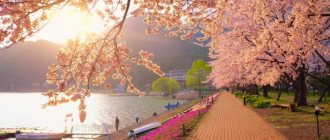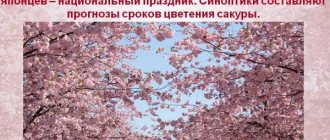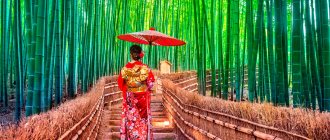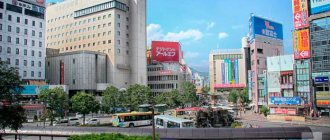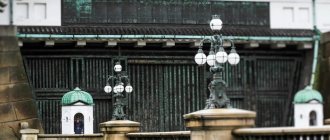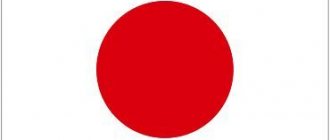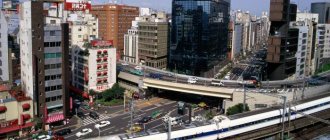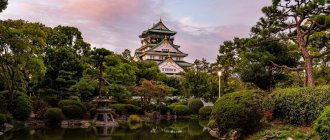Spring in Japan can only mean one thing: cherry blossoms.
Situated between the long, brutal winter months and the humid, hot summer, spring is the most popular time of year for tourism in Japan, both domestic and overseas. Sakura tours to Japan allow you to immerse yourself in this infectious atmosphere, when the parks are filled with revelers and supermarket shelves are stocked with cherry blossom-scented snacks and drinks.
The cherry blossom front spreads across the country, starting in February in Okinawa in the south and reaching Hokkaido in May. Cherry blossoms can be affected by a number of factors: a particularly cold winter can mean the flowers appear late, mild weather causes them to appear early, and heavy rain can cause the petals to fall off much faster. For this reason, before planning a spring vacation in Japan, you need to study the cherry blossom forecast.
WHEN SAKURA BLOWERS IN JAPAN
Due to huge public interest, the National Meteorological Agency of Japan, during the cherry blossom season, in addition to the usual forecasts, talks about the beginning and stages of flowering of Japanese cherry trees in various regions of the country.
Flowering usually begins in late January-early February in Okinawa, then moving with spring to northern Japan. At the beginning of April there is a full blossom on the islands of Kyushu and Shikoku, at the end of March sakura blooms in Tokyo, in the first ten days of April - in Kyoto and Osaka, in Sakiminato and Matsue - in mid-April. By the beginning of May, the wave of cherry blossoms reaches the island of Hokkaido, the cities of Hakodate and Sapporo.
The whole country is watching the movement of sakura to the north. On TV, after the weather forecast, they will definitely say where the sakura is already blooming in full swing, and where it will bloom any day now.
We will also follow Sakura together with you and our tourists who go on cruises around Japan this spring.
Cherry blossom festival
When cherry blossoms bloom in Japan, admiring the blossoms becomes widespread and turns into a national holiday called Hanami. The appearance of Hanami dates back to the Nara period (8th century). It belongs to one of the most beloved and revered traditions in Japan.
Well-established rituals, folk beliefs, ideas for inspiration and creativity are associated with the holiday:
- A sign for the harvest . In Japan, the beginning of cherry blossoms was an important event, as it opened the rice planting season, and the length of the flowering period predicted what the harvest would be like.
- Chanting by poets, artists, musicians. The charming beauty of flower clouds inspired art masters to create works. Dedicated to the sacred tree. Under the sakura, the famous “renga” poems about life and love were born, created by several poets “in a chain” in a circle.
- Ancestor veneration. According to the Japanese, the souls of dead ancestors and samurai heroes live in sakura trees. The warriors were called the “color of the nation” and their lives were compared to cherry blossoms. Historically, rice wine was offered to them under the flowering canopy. Over time, this tradition grew into relaxing under the cherry blossoms - Hanami.
When cherry blossoms bloom in Japan, residents relax under the trees. This is called Hanami. - Eating under sakura is healing . The celebration is like a big picnic in nature. People sit in the shade of trees, have lunch, talk quietly, just remain silent. It is believed that even drinking a cup of tea in the divine aura under the sakura is healing, as it contains pollen from the sacred tree. During rest, no one makes noise or litters. All waste is collected in special garbage bags and baskets, which are distributed to guests here.
The capital Tokyo is recognized as the most popular and widely visited place during the Hanami period.
There are three popular Hanami venues in the city:
- Shinjukugeen National Park . The national park of the metropolis ranks first on the list and has 1,500 plants, including 75 species of sakura. Hanami's opening takes place in the presence of the imperial couple. Places for admiring flowers are reserved in advance. To do this, leave a mat under the tree with the name of the group or the name of the person and the time of stay. Seats for guests are reserved in advance by special companies.
- Ueno Park . The second most popular place is Ueno City Park, which has an area of 625 m². There are 1,100 flowering trees in the park.
- Sumida Park . Sumida Park is the third place for a successful cherry blossom holiday. Traditionally, admiring the blossoms takes place during the day. However, in order to extend the time and opportunity for contemplation, traditional Japanese paper lanterns are lit in all parks in the city in the evening. This park has a unique evening illumination of flowering trees.
There is no specific date for this holiday in the Japanese calendar. The dates of celebration are not fixed, but “floating”. The onset of the holiday of admiring the blossoms is associated with a miracle of nature. Hanami is not an ordinary holiday, but a personal, conscious, emotional experience for each person. People are focused in their thoughts, but at the same time positive, and the holiday turns out to be bright and joyful.
The short cherry blossom season is “extended” with the help of modern technologies. Joyful moments and reminders of the most beautiful moments of spring can be seen all year round by contemplating artificial trees, on which small LED lamps are placed instead of flowers.
Thanks to the amazing combination of ancient traditions with the latest technologies, many museums in Japan have special “surprise” exhibitions to enjoy cherry blossoms at any time of the year. Museum exhibits contain an aroma installation.
Visitors, when viewing paintings with images of sakura, feel the aroma of a flowering tree. In aromatherapy it is sweetish. The slightly sugary aroma of cherry tones and relieves fatigue. The painted sakura does not fall, but reminds of the symbolic meaning of flowers.
Festival Venues
Hanami are held all over the country, but there are some festivals that are the largest and most famous. Hirosaki Park in Aomori Prefecture is home to a historic castle whose architecture adds even more charm to an already wonderful event.
- The Shinjuku Ge-en National Garden, stretching across two districts of the Japanese capital, is in the center of the busiest metropolis. The territory consists of gardens in traditional French, English and Japanese styles, each of which is a separate part of the park.
- Ueno Park in Tokyo is the most popular park in Japan. About 800 cherry trees grow there, birds also live there, and there are temples and museums. It is known that some types of sakura begin to bloom earlier than other varieties in Tokyo.
- Mitsuiki Park is located in Yokohama, the second most populous city in Japan. It is noteworthy that the park's sakura collection includes about 80 species of trees, many of which bloom at different times of the year, which significantly expands the hanami.
- The Meguro River flows about five miles from Tokyo. Over half a mile of its banks are lined with cherry blossom trees, and paper lanterns along the water make the river an even more ideal setting. In addition, there are many museums and restaurants, allowing Japanese and tourists to fully enjoy the hanami and admire the scenery.
In fact, the tradition of celebrating flowering has migrated from Japan to other countries. For example, in New South Wales, Australia, there are several cities where cherry blossoms are one of the main events on the calendar. It is celebrated every September in the Kaura Japanese Garden. In Russia, sakura was planted in Yuzhno-Sakhalinsk. This is a fairly large area on the territory of the Local History Museum. The trees were brought from Japan in 2006, and the first alley was built in Gagarin Park. In Moscow there is a Japanese Garden in the Main Botanical Garden named after Tsitsin. There are about 250 sakura trees growing there.
The cherry blossom is an important symbol of Japan, loved by millions of people from different countries. The spectacle is so enchanting that other cultures gradually borrow the hanami tradition.
Where it blooms
Considering that the climate is warmer on the southern islands, cherry trees begin to bloom in this part of the country. Starting from Okinawa. On the other islands, spring cherry blossoms come later. Gradually reaching and stopping at the northernmost part of Japan - Hokkaido. This smoothly moving wave is called the “sakura blossom front.”
In cities, delicate flowers bloom near temples and palaces, in parks and squares. Since the cherry blossom period is not particularly long (on average 7-10 days maximum), the local population tries to spend as much time as possible near the trees. By the way, if it rains, the flowers are overwhelmed by rain, and this period becomes much shorter.
Theoretically, you can travel around the country, along the cherry blossom route, from one province to another and admire the magic. If you are interested, there are numerous special tours to Japan to watch the buds bloom. Sometimes, you can even visit several islands during a trip.
Where did the holiday come from?
Almost seventeen centuries ago, the emperor and Japanese aristocrats decided to hold a holiday for themselves, where they would admire the cherry blossoms with their family. The tradition became annual, and all the nobility, samurai and subsequently ordinary people joined it. In the name of this day, poems and songs were composed. Wonderful treats were being prepared everywhere.
The holiday was associated not only with spring, new life, but also with the time when it was time to plant rice. Therefore, people rejoiced and hoped for a good harvest. To do this, they brought gifts, ritual gifts to sakura, as to a deity. Now days of admiration are celebrated throughout Japan, and none of its residents will allow themselves to miss them.
Hanami
The celebration acquired an unusual name - “hanami”, meaning admiring flowers. The celebration begins with watching the flowering of the fruitful plum tree. All Japanese and guests of the country observe an amazing phenomenon when all city streets are painted in multi-colored colors and shades, which look even more magical in the light of the sun's rays.
Today, the tradition of enjoying spring blossoms has transformed from national to global. The areas where sakura and related plants grow began to host festivals, holidays and flash mobs. The cities of South Sakhalin, Uzhgorod, Dutch Amsterdam and American Chicago joined Japan. (see traditions of the Nauryz holiday)
Residents and guests of these cities, and, of course, the Japanese, put aside all non-urgent matters during the week and try to walk through parks, alleys, groves and sit under the spring blooming cherry trees. Moreover, at different times of the day, the “petals” of the trees turn almost all the colors of the rainbow and delight their viewers with amazing shades and tints.
During this brilliant period, according to the beliefs of the ancients, the leaves that fell acquired magical powers - they demonstrated the beauty, well-being and transience of life. At this time, residents thought that they needed to live in the present and enjoy every moment of the day, because human life, like sakura, is not in its prime for so long. The main thing is to have time to realize yourself and enjoy every moment.
New Year in Rus' before Ivan's decree
What date was the New Year celebrated during paganism, why did the Slavs celebrate it in the spring? What old Russian traditions have survived to this day?
The best places to watch the blooms
Every year, researchers compile a top list of the brightest and most unusual places to celebrate cherry blossoms.
The Imperial Park in Tokyo stands apart from this list - it is striking in its area and rich history. Designers and florists have created an incredible atmosphere of flowering that lasts quite a long time - this was achieved by planting different varieties of trees.
Another amazing place in the capital of Japan is Ueno Park, where sakura blooms earlier than in other places. There is not only a park here, but also a zoo, so tourists love this attraction and definitely try to visit it.
In Kitanomaru Park (Tokyo) there are numerous bodies of water where you can swim, admiring the cherry blossom branches hanging down to the water.
Locals recommend watching the evening blooms in Sumida Park, which includes the Senso-ji chrome complex and the Tokyo Sky Tree tower.
The northern city of Kyoto delights visitors and residents with a philosophical path lined with flowering trees on both sides. It leads to the temple and resembles a tunnel of pink and white flowers. One of the oldest sakura trees in Maruyama Park also grows here; it is more than 70 years old. (see lunar health calendar for 2021)
You can combine cultural and spiritual relaxation in Kema Sakuranomiya Park in Osaka, where, after admiring the architecture and landscape of the castle complex, you can stroll along the cozy sakura alleys.
